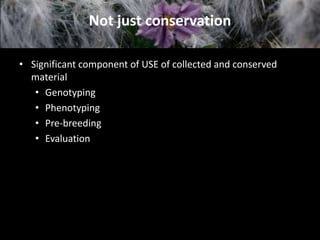Introduction to prebreeding component of CWR project
- 1. Adapting agriculture to climate change: collecting, protecting and preparing crop wild relatives Hannes Dempewolf - The Global Crop Diversity Trust - http://croptrust.org
- 2. What is the Global Crop Diversity Trust? • Public-private partnership raising an endowment fund that will provide continuous funding for key crop diversity collections (starting with international collections maintained by CGIAR Centres) • Goal: “to advance an efficient and sustainable global system of ex situ conservation by promoting the rescue, understanding, use and long-term conservation of valuable plant genetic resources” • Part of the funding strategy of the International Treaty for Plant Genetic Resources for Food and Agriculture (ITPGRFA)
- 4. Svalbard Global Seed Vault
- 5. A global initiative on crop wild relatives • Identify, collect, conserve, document and use key crop wild relative diversity for climate change adaptation (in developing countries) • 10 year funding pledged by Norwegian government, starting 2011 • 26 target crops: alfalfa, apple, bambara groundnut, banana, barley, bean, carrot, chickpea, cowpea, eggplant, faba bean, finger millet, grasspea, lentil, oat, pea, pearl millet, pigeon pea, potato, rice, rye, sorghum, sunflower, sweet potato, vetch and wheat
- 6. Targeting “missing” diversity: potato CWRs http://gisweb.ciat.cgiar.org/GapAnalysis/
- 7. Targeting threatened diversity: Phaseolus
- 8. Targeting threatened diversity: 12 genepools
- 9. Not just conservation • Significant component of USE of collected and conserved material • Genotyping • Phenotyping • Pre-breeding • Evaluation
- 10. Pre-breeding “It's a bit like crossing a house cat with a wildcat. You don't automatically get a big docile pussycat. What you get is a lot of wildness that you probably don't want Iying on your sofa.”
- 11. Possible CWR pre-breeding and evaluation strategies • Assess genetic diversity of accessions, pick set of diverse CWR genotypes and cross with cultivars, create BCs and RILs and evaluate • First evaluate CWRs, then pick most promising genotypes and use in pre-breeding with cultivated lines, evaluate again • QTL (and MAS) approaches • Candidate gene approach • Sequence-based transcriptomics (to identify expression differences under stress) …. ?
- 12. Survey of pre-breeding experts 1. Which wild species or population(s) of crop wild relatives do you think should be targeted first and foremost? 2. Which wild species or population(s) do you feel are currently under-represented in ex situ collections and should be targeted during the collecting activities of this project? 3. Which traits would you target (especially with reference to traits that are important in a climate change context)? So far a total of 98 expert responses were collected
- 13. Some issues to consider… • Focus on species that are easiest to use or more difficult to use and less well known but perhaps more interesting? • What kinds of outputs of the project would be maximally useful to the breeding community? • What can be done to make breeders around the world aware of the newly collected germplasm?
- 14. Expected Outputs of the meeting: A. Where we are: Synthesis of past experiences and challenges of the use of CWRs in potato pre-breeding
- 15. Expected Outputs of the meeting: B. Where we should be going: Synthesis of expert opinions on the best ‘way forward’ with regards to the use of CWRs in potato pre-breeding: • Which traits should pre-breeding efforts focus on in the context of climate change? • Which CWR taxa are promising but have so far largely remained unexploited? • Where do such taxa occur and what should priorities be for future collecting? • What are the main obstacles for an increased use of CWR in potato pre-breeding (e.g. taxonomical issues; access regimes to PGR; funding constraints; etc.) and how can we overcome them?
- 16. Program overview DAY 1: • Welcome and introduction • Setting the scene: Species diversity of potato CWRs and historical perspectives on the use of CWRs in potato pre-breeding • Participants report on experiences, accomplishments, challenges and perspectives with the use of CWRs in potato pre-breeding DAY 2: • Potato breeding objectives and climate change • Predictability of systematic relationships and biogeography for the use of CWRs in pre-breeding • Synthesis work towards meeting outcomes
- 17. Program overview DAY 3: • Relevant international and national policies and regulations with regards to potato CWRs • Discussion on: • relevant policies and the role of the public and private sector; • priorities for collecting potato CWRs; • syntheses and the way forward
- 18. Solanum megistacrolobum (credits: Arthur Chapman) Thank you for coming and thank you to CIP for hosting us!
Editor's Notes
- Aegilops columnaris
- Only geo-referenced ones (about 1/3 of total)
- Distribution models (left); Gaps (right)
- It shows the absolute change in species richness (ie. Future richness minus current richness) for all the wild relatives of 12 genepools (those that we included in our first gap analysis), considering unlimited species dispersal (i.e. species can move anywhere where climate is suitable in the future –no barriers). Done for the emissions scenario SRES-A2 by 2050s. To produce it you model the distribution of each crop wild relative under present day conditions and then bin the distributions (0,1 maps), then sum those up to get the richness map. Do the same for the future and then take the difference.

















